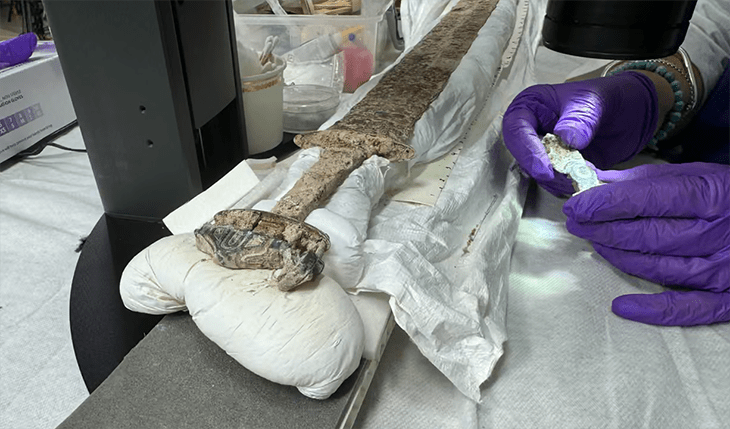

A groundbreaking discovery in England is shaking the foundations of our understanding of Anglo-Saxon history. An almost pristine 6th-century sword, unearthed from an elite burial site in Kent, is not just a relic—it’s a treasure trove of insight into the lives and culture of a long-lost society. Alongside this exceptional blade, archaeologists have uncovered other grave goods that are revealing key details about the Anglo-Saxons—details that have remained hidden for centuries.
This unprecedented find offers a rare, breathtaking glimpse into a pivotal era, one that was once shrouded in mystery. Unlike the typical corroded and fragmented swords that usually surface in British excavations, this one remains a stunning testament to the craftsmanship of the time. With intricate gilt and silver inlays decorating the hilt, and runes engraved along its surprisingly intact blade, this sword pushes the boundaries of what we thought we knew about Anglo-Saxon artifacts.

“It’s really incredible, in the top echelons of swords, an elite object in every way, which is wonderful. It rivals the swords from Dover and from Sutton Hoo,” said Duncan Sayer, the lead archaeologist on the excavation and professor of archaeology at the University of Central Lancashire. Sayer is no stranger to significant discoveries—he’s referencing the famous burial mound in Suffolk and in Dover, long been celebrated as among the most important archaeological sites in England.
So why does this sword matter so much? For starters, it sheds light on a society that left behind scant written records. History often refers to this period as the “Dark Ages” due to the lack of contemporary sources. What we do know about the Anglo-Saxons mostly comes from later accounts, and much of their material culture, especially the elite, remains elusive. This sword, therefore, represents not just a luxury object but a key to unlocking the social structures, craftsmanship, and possibly even the beliefs of a society that helped lay the foundations for modern Britain.
The discovery occurred in a cemetery reserved for high-status individuals, a site that archaeologists are understandably keeping under wraps for the time being, given its immense historical and monetary value. “We have fairly sparse historical sources when it comes to this period,” explained Professor Alice Roberts, the presenter of the BBC’s Digging for Britain and a long-time expert in the field. “It’s an extraordinary Anglo-Saxon cemetery, with really beautifully furnished graves.” For Roberts, who has spent over a decade hosting the program, this sword represents a once-in-a-lifetime find: “I’ve never seen anything like this in all my years of hosting the show,” she added.
The site, which has been kept secret from the public, also offers tantalizing glimpses of Anglo-Saxon life, particularly the material culture of the elites. Beyond the sword, other grave goods reveal the complexity and richness of the society, suggesting a level of sophistication that contrasts with the simplistic, almost mythic view of the Anglo-Saxons as primitive warriors. These artifacts not only inform us about the individuals buried there but also about the wider Anglo-Saxon world—its trade networks, artistic achievements, and perhaps even its spiritual practices.
In terms of its historical significance, this sword could change everything we thought we knew about this formative period in British history. The precision with which the sword was forged and decorated suggests a level of expertise and luxury that challenges outdated assumptions. It’s no longer enough to view the Anglo-Saxons simply as raiders or brutish settlers; this discovery forces us to reconsider their cultural sophistication. The sword, with its runes and silver inlays, speaks volumes about the technological prowess and artistry of those who crafted it. The object transcends its utilitarian function; it becomes a symbol of power, status, and cultural identity.
While the world watches in awe, the archaeological team continues its painstaking work, knowing they are uncovering something that could reshape our understanding of the Anglo-Saxon world. As historian and archaeologist Duncan Sayer notes, this site is not just about relics; it’s about the stories these objects can tell us. “It’s really incredible, in the top echelons of swords, an elite object in every way, which is wonderful.”
The find is part of the 12th season of the BBC’s Digging for Britain, which is set to dive deeper into the mystery surrounding this Anglo-Saxon burial site. With each new detail that emerges, the world of the Anglo-Saxons grows more complex and fascinating. As this sensational discovery continues to be analyzed, it promises to rewrite history—offering a clearer, more nuanced understanding of a civilization that was once relegated to the shadows.
For now, the sword and its accompanying grave goods remain under wraps, their secrets waiting to be fully revealed. But one thing is clear: the Anglo-Saxons were far more advanced, far more intricate, and far more influential than we ever realized.
What are your thoughts? Please comment below and share this news!
True Activist / Report a typo






